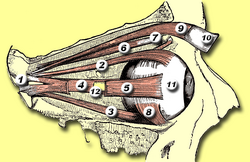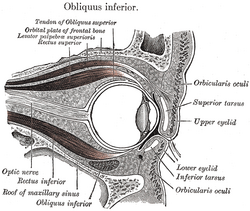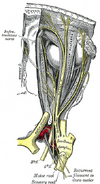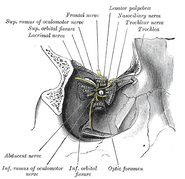Assessment |
Biopsychology |
Comparative |
Cognitive |
Developmental |
Language |
Individual differences |
Personality |
Philosophy |
Social |
Methods |
Statistics |
Clinical |
Educational |
Industrial |
Professional items |
World psychology |
Biological: Behavioural genetics · Evolutionary psychology · Neuroanatomy · Neurochemistry · Neuroendocrinology · Neuroscience · Psychoneuroimmunology · Physiological Psychology · Psychopharmacology (Index, Outline)
| Levator muscle of upper eyelid | ||
|---|---|---|
| Rectus muscles: 2 = superior, 3 = inferior, 4 = medial, 5 = lateral Oblique muscles: 6 = superior, 8 = inferior Other muscle: 9 = levator palpebrae superioris Other structures: 1 = Annulus of Zinn, 7 = Trochlea, 10 = Superior tarsus, 11 = Sclera, 12 = Optic nerve | ||
| Sagittal section of right orbital cavity. | ||
| Latin | musculus levator palpebrae superioris | |
| Gray's | subject #227 1021 | |
| Origin: | sphenoid bone | |
| Insertion: | tarsal plate, upper eyelid | |
| Artery: | ophthalmic artery, superior ophthalmic vein | |
| Nerve: | oculomotor nerve | |
| Action: | retracts//elevates eyelid | |
| Antagonist: | orbicularis oculi muscle | |
| Dorlands/Elsevier | m_22/12549616 | |
The levator palpebrae superioris (or levator muscle of upper eyelid) is the muscle in the orbit that elevates the superior (upper) eyelid.
Structure[]
The levator palpebrae superioris originates on the lesser wing of the sphenoid bone, just above the optic foramen. It broadens and becomes the levator aponeurosis. This portion inserts on the skin of the upper eyelid, as well as the superior tarsal plate. It is a skeletal muscle. The superior tarsal muscle, a smooth muscle, is attached to the levator palpebrae superioris, and inserts on the superior tarsal plate as well.
Innervation[]
As with most of the muscles of the orbit, it is innervated by the superior division of the oculomotor nerve (Cranial Nerve III). This is why when one looks upward, the eyelid tends to move up with it. [1] An adjoining smooth muscle, the superior tarsal muscle, is sympathetically innervated and is occasionally considered to be part of the levator palpebrae superioris.
Actions[]
The levator palpebrae superioris muscle elevates and retracts the upper eyelid.
Pathology[]
Damage to this muscle, or its innervation, can cause ptosis, the drooping of the eyelid. Ptosis can also be caused by damage to the adjoining superior tarsal muscle, or its sympathetic innervation. Such damage to the sympathetic supply occurs in Horner's syndrome, and presents as a partial ptosis.
Additional images[]
See also[]
- Superior tarsal muscle
- Ptosis
References[]
- ↑ "eye, human."Encyclopædia Britannica. 2008. Encyclopædia Britannica 2006 Ultimate Reference Suite DVD 5 Apr. 2008
External links[]
scalp/eyelid: occipitofrontalis (occipitalis, frontalis) - orbicularis oculi - corrugator supercilii - depressor supercilii
extraocular: levator palpebrae superioris - superior tarsal - rectus (superior, inferior, medial, lateral) - oblique (superior, inferior) - intraocular: ciliary - iris dilator - iris sphincter
ear: auriculares - temporoparietalis - stapedius - tensor tympani
nose: procerus - nasalis (dilatator naris) - depressor septi nasi - levator labii superioris alaeque nasi
mouth: levator anguli oris/depressor anguli oris - levator labii superioris/depressor labii inferioris - zygomaticus (major, minor) - mentalis - buccinator - orbicularis oris - risorius
mastication: masseter - temporalis - pterygoid (lateral, medial)
tongue: extrinsic (genioglossus - hyoglossus - chondroglossus - styloglossus) intrinsic (superior longitudinal - inferior longitudinal - transversus - verticalis)
soft palate: levator veli palatini - tensor veli palatini - musculus uvulae - palatoglossus - palatopharyngeus
pharynx: pharyngeal constrictor (inferior, middle, superior) - stylopharyngeus - salpingopharyngeus
larynx: cricothyroid - posterior cricoarytenoid - lateral cricoarytenoid - arytenoid - thyroarytenoid
| This page uses Creative Commons Licensed content from Wikipedia (view authors). |






